To preserve vitamins when air frying vegetables, keep the temperature moderate and cook for a shorter time, as high heat and long cooking can break down heat-sensitive nutrients like vitamins C and B. Minimal oil and uniform cooking help retain water-soluble vitamins. Choosing dense vegetables and pre-steaming can also boost nutrient retention. If you want to learn more about optimizing nutrient preservation in air-fried dishes, there’s helpful advice coming up.
Key Takeaways
- Air frying preserves more nutrients than boiling or roasting due to minimal water use and rapid, high-temperature cooking.
- Using moderate temperatures and shorter cooking times helps retain heat-sensitive vitamins like C and B-complex.
- Applying minimal, evenly spread oil and avoiding heavy coatings support nutrient retention during air frying.
- Selecting dense, firm vegetables like carrots and broccoli enhances vitamin stability compared to leafy greens.
- Light steaming before air frying can further protect and preserve sensitive vitamins in vegetables.
How Air Frying Affects Vegetable Nutrients
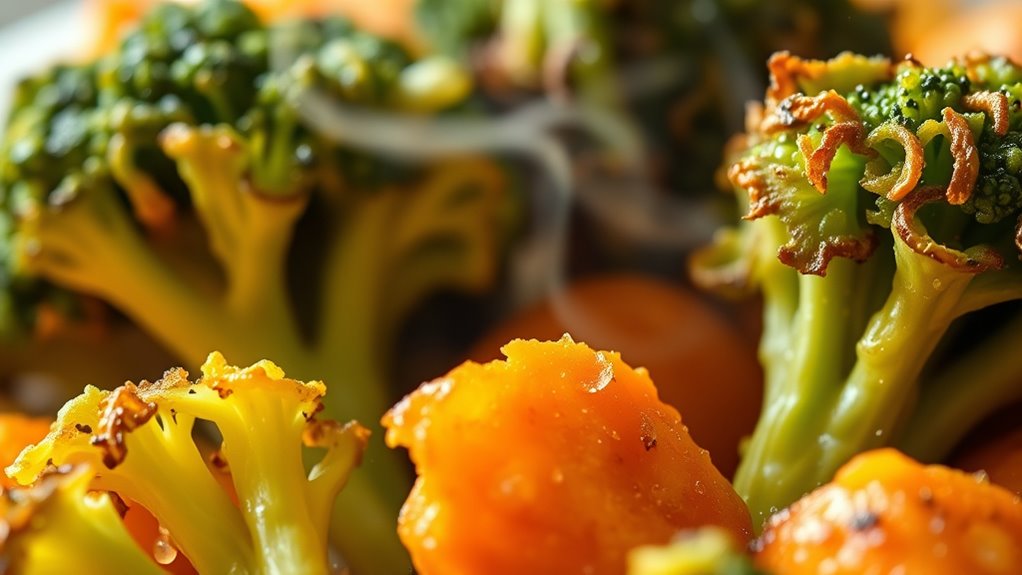
While air frying is a popular method for preparing vegetables quickly and with less oil, it can also impact their nutrient content. The high heat and rapid cooking process may cause some vitamins, especially water-soluble ones like vitamin C and certain B vitamins, to break down more quickly than in raw or traditionally cooked vegetables. Additionally, high-temperature cooking can accelerate nutrient degradation. However, because air frying uses less water and shorter cooking times, it can preserve other nutrients better than boiling or steaming. The overall effect on vitamins depends on factors like cooking duration and temperature. Additionally, using appropriate temperature controls can help minimize nutrient loss during air frying. While some nutrient loss is inevitable, air frying often retains more nutrients than methods involving prolonged or high-temperature cooking. Properly timing and temperature control can help maximize nutrient retention during air frying.
The Role of Temperature in Vitamin Retention
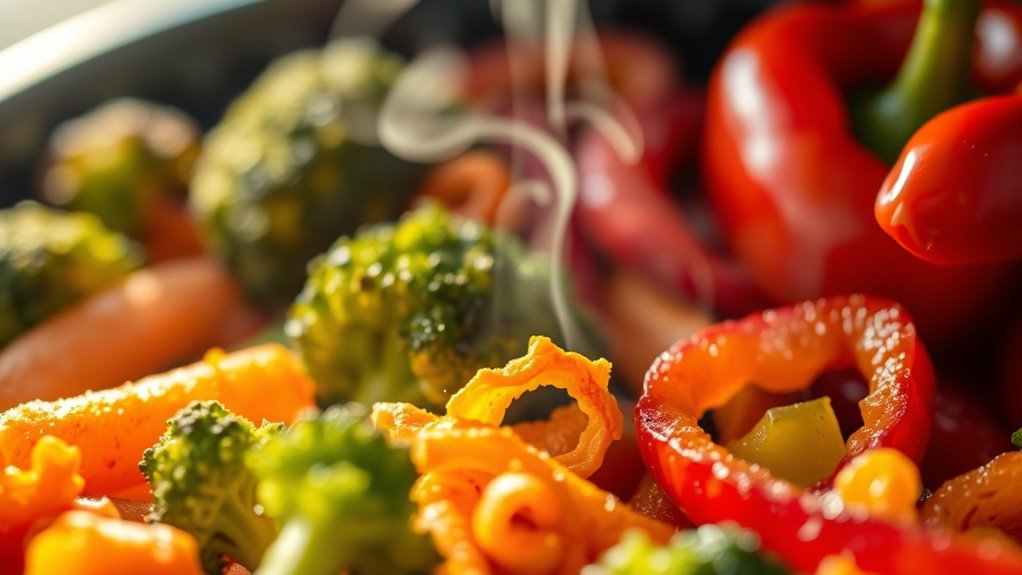
Temperature plays a crucial role in determining how well vitamins are preserved during air frying. Higher temperatures can break down heat-sensitive vitamins like C and B-complex, leading to nutrient loss. Conversely, cooking at moderate temperatures helps retain more of these nutrients by reducing exposure to excessive heat. If you set your air fryer too high, you risk degrading valuable vitamins, especially in delicate vegetables. On the other hand, cooking at too low a temperature might not cook the vegetables thoroughly, affecting texture and flavor. Finding the right balance is key. You should aim for a temperature that effectively cooks your vegetables without compromising their nutritional content. Monitoring and adjusting your air fryer’s temperature ensures you maximize vitamin retention while still enjoying delicious, properly cooked vegetables. Additionally, using low-temperature cooking methods can further help preserve sensitive vitamins during food preparation. Being aware of temperature control techniques can help optimize nutrient retention and overall dish quality. Proper cooking technique and timing also contribute significantly to maintaining vitamin levels during air frying. Understanding the impact of heat on nutrients can guide you in selecting the best temperature settings for maximum health benefits.
Time Matters: Cooking Duration and Nutrient Loss

Extending the cooking time in your air fryer can lead to significant nutrient loss, especially for heat-sensitive vitamins like C and B-complex. The longer vegetables cook, the more nutrients degrade. To preserve vitamins, keep your cooking time as short as possible.
- Use the lowest effective temperature for your recipe
- Check vegetables frequently to avoid overcooking
- Cut vegetables into uniform pieces for even cooking
- Avoid pre-cooking or excessive pre-treatment
- Remove vegetables promptly once they reach desired tenderness
Comparing Air Frying to Other Cooking Methods
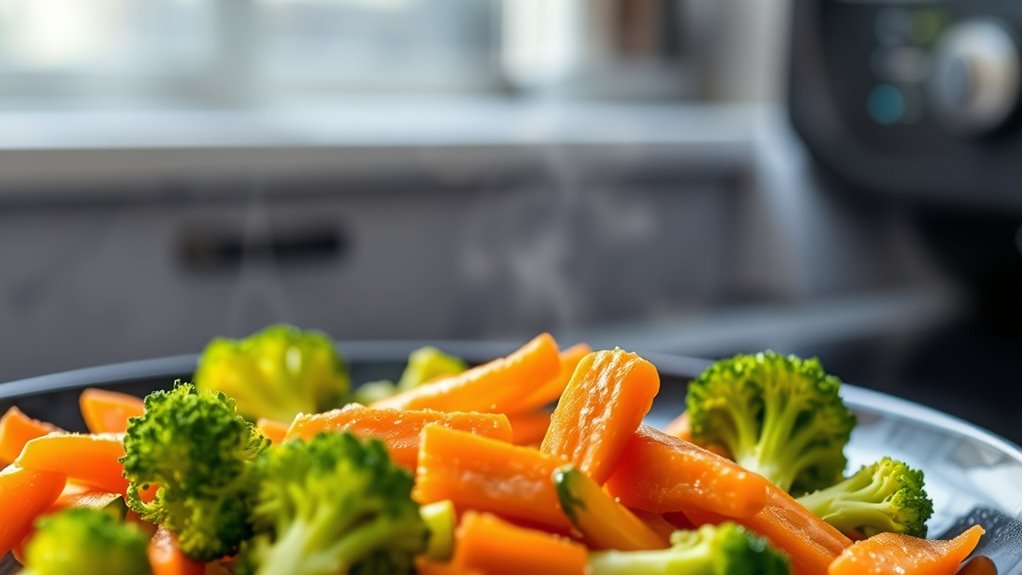
Compared to methods like boiling, steaming, or roasting, air frying often preserves more nutrients in vegetables because it uses less oil and cooks at high temperatures quickly. Boiling can cause water-soluble vitamins, like vitamin C and B vitamins, to leach into the water, reducing their levels in the food. Steaming preserves nutrients better than boiling but still involves longer cooking times, which can lead to some nutrient loss. Roasting exposes vegetables to high heat for extended periods, potentially degrading heat-sensitive vitamins. Air frying combines rapid cooking with minimal oil, which helps retain more vitamins. Its high-temperature, short-duration approach minimizes nutrient destruction, making it an effective method for preserving the vitamin content in your vegetables compared to traditional techniques. Additionally, seasonal variations can influence the nutrient levels in vegetables, emphasizing the importance of choosing proper cooking methods to optimize vitamin retention. Proper storage techniques before cooking are also crucial for maintaining vegetable nutrients and ensuring maximum vitamin preservation.
Types of Vegetables That Retain Nutrients Best

Certain vegetables naturally retain more nutrients when cooked with air frying, especially those with dense, firm textures or lower water content. These types withstand heat better and minimize nutrient loss. Leafy greens, like spinach and kale, tend to lose fewer vitamins because they cook quickly and retain moisture. Root vegetables such as carrots, sweet potatoes, and parsnips hold their nutrients well due to their dense structure. Cruciferous vegetables like broccoli and cauliflower retain more vitamins when air fried because they’re less prone to overcooking. Additionally, bell peppers and zucchini keep their vitamin C content better with this method. Incorporating proper cooking techniques can further help preserve the nutrients in your vegetables.
Tips to Maximize Vitamin Preservation in Air Fried Vegetables

To preserve the maximum amount of vitamins when air frying vegetables, you should start by paying attention to preparation methods. Wash vegetables gently to remove dirt without soaking, which can leach nutrients. Cut them into uniform pieces to ensure even cooking, reducing the time needed and minimizing nutrient loss. Use minimal or no oil, as excessive oil can create a barrier that prevents heat from penetrating and damaging nutrients. Preheat your air fryer to the appropriate temperature — lower heat settings help preserve heat-sensitive vitamins like C and B. Avoid overcooking; check vegetables early to prevent nutrient degradation. Additionally, automation in food preparation technologies can assist in monitoring cooking times and temperatures to optimize vitamin retention. Recognizing patterns in angel numbers can also inspire mindful cooking practices and enhance your overall health journey. Incorporating proper cooking techniques ensures you maximize nutrient preservation while enjoying flavorful vegetables. Finally, consider steaming vegetables briefly before air frying to lock in nutrients, then finish with a quick crisp for texture without excessive nutrient loss.
The Impact of Prepping and Storage on Nutrient Content

Prepping and storage methods substantially influence the nutrient content of your vegetables before air frying. How you handle produce can determine how many vitamins stay intact. For example, cutting vegetables into small pieces exposes more surface area, leading to faster nutrient loss. Storing vegetables in the fridge slows degradation, but prolonged storage causes vitamin deterioration. Rinsing vegetables thoroughly removes dirt but can also wash away water-soluble vitamins if done excessively. Using airtight containers minimizes oxygen exposure, helping preserve nutrients. Additionally, peeling reduces fiber and nutrients, so keep skins when possible. Proper storage and prepping techniques help retain essential vitamins, ensuring your vegetables are as nutritious as intended when you cook. Vacuum sealing can also be an effective method to reduce oxygen exposure and prolong freshness. Being mindful of these steps can make a significant difference in nutrient preservation, especially considering the market growth in AI-driven food preservation technologies. Incorporating emotional triggers into educational campaigns about food preservation can motivate consumers to adopt better storage practices. Furthermore, understanding how food storage impacts vitamin retention encourages more mindful preparation routines.
Understanding Heat-Sensitive Vitamins in Vegetables

Heat-sensitive vitamins like C and B are easily affected by cooking methods, including air frying. You need to understand how factors like cooking time and temperature influence their stability. By controlling these variables, you can better preserve these essential nutrients in your vegetables. For example, using lower temperatures and shorter cooking times can help maintain vitamin content during air frying. Additionally, understanding the nutrient degradation process can guide you in optimizing your cooking techniques to maximize vitamin retention. Proper knowledge of nutrient stability can enable you to select optimal air frying settings. As ancient wisdom from Egyptian scribes emphasizes, “truth and integrity in practices lead to better preservation of essential qualities,” highlighting the importance of careful technique in nutrient retention.
Vitamin Stability Factors
Understanding the factors that affect vitamin stability is essential when cooking vegetables in an air fryer. Several elements influence how well heat-sensitive vitamins, like vitamins C and B, retain their nutrients.
- Temperature: Higher temperatures accelerate vitamin breakdown.
- Cooking time: Longer cooking increases nutrient loss.
- pH levels: Acidic or alkaline conditions can degrade certain vitamins.
- Oxygen exposure: Air contact promotes oxidation, harming vitamins.
- Water content: Moisture can facilitate nutrient leaching or degradation.
- Cooking environment: The enclosed air circulation in an air fryer can influence oxidation rates and nutrient preservation.
Heat Impact on Nutrients
Since heat can directly influence the stability of certain vitamins, it is crucial to grasp how cooking methods like air frying impact these nutrients. Vitamins such as C and B-complex are heat-sensitive and can break down when exposed to high temperatures. Optimal cooking techniques can help minimize nutrient loss during air frying. Air frying uses hot air circulation, which cooks food quickly and often at high temperatures, increasing the risk of nutrient loss. You might notice a reduction in vitamin content after air frying, especially if you cook vegetables for too long or at excessively high heat. To preserve these nutrients, consider adjusting the cooking time and temperature, or lightly steaming vegetables beforehand. Incorporating gentle cooking methods can further help retain more vitamins during preparation. Additionally, understanding nutrient stability can guide you in choosing the best cooking practices to retain maximum vitamins. By understanding how heat affects vitamins, you can optimize your air frying techniques to retain more nutrients in your vegetables.
Cooking Time Effects
Cooking time plays a crucial role in determining how much of your vegetables’ heat-sensitive vitamins, like C and B-complex, remain after air frying. The longer you cook, the greater the vitamin loss. To preserve nutrients, keep cooking times short and avoid overexposure to heat.
- Shorter cooking times minimize vitamin degradation
- High temperatures accelerate nutrient loss
- Stir or shake vegetables during cooking for even heat distribution
- Cutting vegetables into larger pieces reduces surface exposure
- Using a lower temperature setting helps preserve sensitive vitamins
The Effect of Oil Use and Coating on Nutrient Preservation
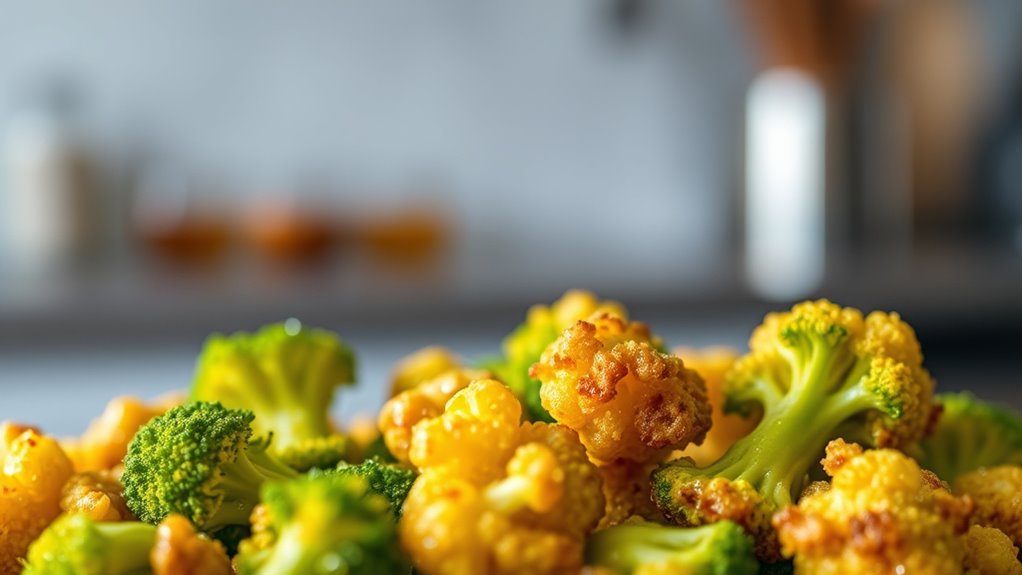
The amount of oil you use and how thickly you coat vegetables can influence nutrient retention during air frying. Too much oil or a heavy coating may reduce vitamin levels, while a light coat helps preserve more nutrients. Understanding these factors helps you optimize your cooking for healthier, nutrient-rich vegetables.
Oil Quantity Impact
Using oil in air frying can considerably influence nutrient preservation, especially when it comes to vegetables. The amount of oil you use affects how well vitamins stay intact during cooking. Too much oil can create a barrier, reducing nutrient loss but potentially adding unnecessary fat. Conversely, minimal oil may help preserve water-soluble vitamins like C and B, which are sensitive to heat and oxidation.
Consider these points:
- Smaller oil quantities reduce nutrient leaching.
- Excess oil may create a greasy coating, diminishing nutrient stability.
- Light oil application helps maintain flavor without compromising vitamins.
- Overuse can increase calorie content, affecting health benefits.
- Proper oil amount ensures even cooking and nutrient retention.
Choosing the right oil quantity balances flavor, health, and vitamin preservation.
Coating Thickness Effect
Applying the right amount of oil creates a coating that directly influences how nutrients are preserved during air frying. A thin, even layer helps lock in moisture and nutrients, while a thick coating can trap steam and heat, potentially degrading sensitive vitamins. When you use too much oil, the excess can create a barrier that prevents heat from penetrating evenly, risking nutrient loss. Conversely, a light coating allows heat to circulate more efficiently around the vegetables, helping to retain vitamins like vitamin C and folate. The coating thickness also affects browning and texture, which can indirectly influence nutrient stability. To optimize vitamin preservation, aim for a moderate, uniform coating that enhances heat transfer without overwhelming the vegetable’s natural structure.
Nutrient Retention Factors
Since oil acts as a heat conductor and barrier, its amount and distribution considerably influence nutrient retention during air frying. Using too much oil can cause nutrients to break down faster, while too little may hinder even cooking. Proper coating helps preserve vitamins by protecting vegetables from direct heat exposure. Additionally, the type of oil impacts nutrient retention, with some oils better at maintaining vitamins. Over-coating can create a barrier that reduces nutrient loss but may also lead to uneven cooking. To optimize vitamin preservation, consider these factors:
- Use minimal oil for even coating
- Choose oils rich in antioxidants
- Avoid excessive oil application
- Distribute oil uniformly
- Monitor cooking time to prevent nutrient degradation
Incorporating Air Fried Vegetables Into a Nutritious Diet
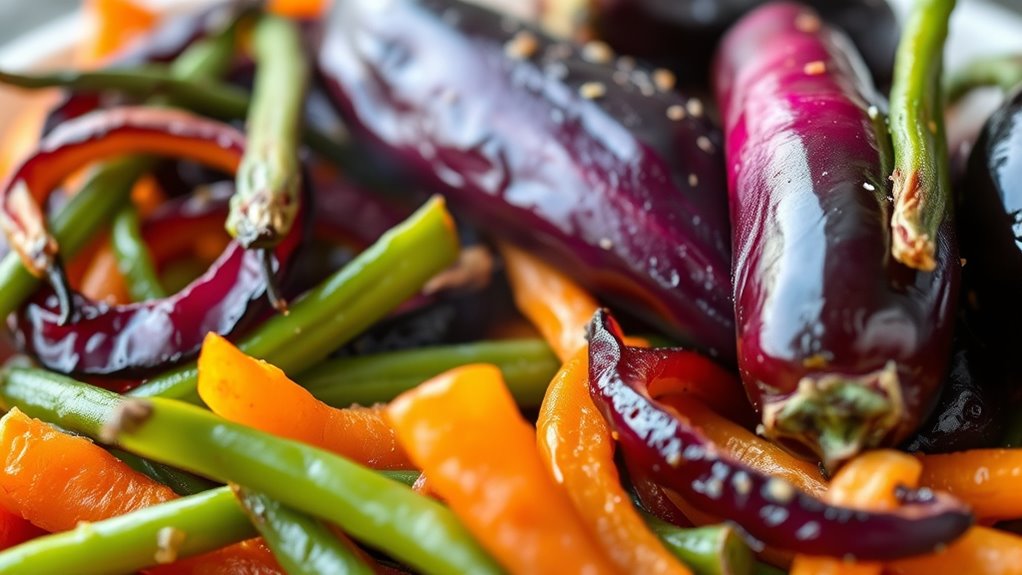
Incorporating air fried vegetables into your diet is an easy way to boost your nutritional intake without sacrificing flavor. Air frying retains more vitamins and minerals compared to traditional methods, making your meals healthier. You can add air-fried veggies to salads, wraps, or serve them as side dishes. They cook quickly, so you save time while maintaining freshness and crunch. Experiment with different vegetables like bell peppers, zucchini, and broccoli to diversify your nutrient profile. Using minimal oil keeps the dish light and preserves the vitamins sensitive to heat and fat. Incorporating these vegetables regularly helps improve your overall diet quality and supports your health goals. The convenience and health benefits make air-fried vegetables a smart addition to your everyday meals.
Frequently Asked Questions
Does the Type of Vegetable Affect Vitamin Preservation in Air Frying?
You might wonder if the type of vegetable influences how well vitamins stay in air frying. Yes, it does. Some vegetables, like spinach or broccoli, have delicate vitamins that degrade quickly with heat, while others like carrots or potatoes hold up better. To maximize vitamin retention, choose vegetables suited for quick cooking and avoid overcooking. Keep in mind, your cooking method and time also play key roles in preserving nutrients.
Are There Specific Air Fryer Settings That Optimize Nutrient Retention?
You want to know if specific air fryer settings can help retain more nutrients. To optimize nutrient preservation, set your air fryer to a lower temperature, around 350°F (175°C), and cook for shorter times. Avoid overcooking, as high heat and extended cooking can destroy vitamins. Use a crisper basket to allow even heat distribution, and check vegetables frequently to prevent nutrient loss while ensuring they’re properly cooked.
Can Marinating Vegetables Before Air Frying Impact Vitamin Content?
Imagine flavor meets nutrition—marinating vegetables before air frying can both enhance taste and impact vitamin content. While marinating adds flavor and tenderizes, it may also cause some water-soluble vitamins, like vitamin C, to leach out into the marinade. To minimize nutrient loss, marinate for a shorter time or use less acidic ingredients. This way, you enjoy delicious vegetables without sacrificing their nutritional value.
How Does Pre-Cooking Preparation Influence Nutrient Preservation?
Pre-cooking preparation, like washing or marinating, can affect nutrient preservation. When you wash vegetables, you might lose some water-soluble vitamins like vitamin C and B. Marinating can also cause nutrient leaching if acids or salts are involved. To maximize nutrient retention, you should handle vegetables gently, use minimal water, and avoid long marination times before air frying. Proper prep helps keep the nutrients intact and boosts flavor.
Is There a Recommended Storage Method to Maintain Vitamins After Air Frying?
You want to preserve vitamins after air frying, and proper storage plays a key role. To keep nutrients intact, store your vegetables in airtight containers, keep them in a cool, dark place, and avoid exposure to light and air. Refrigerate promptly if not eaten immediately, and consume within a few days. This way, you protect their freshness, flavor, and nutritional value, ensuring every bite delivers maximum health benefits.
Conclusion
Remember, you are what you eat, so handle your vegetables with care. Air frying can preserve many nutrients if you cook at the right temperature and time, and choose the right vegetables. By prepping properly and avoiding excessive oil, you’ll maximize vitamin retention. Keep in mind, slow and steady wins the race—so focus on gentle cooking to enjoy the full health benefits of your air-fried veggies. Your body will thank you!









